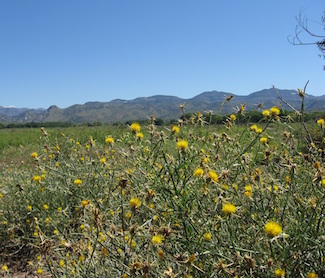 The New Mexico Department of Agriculture released an updated state noxious weed list in June 2020. Yellow starthistle (Centaurea solstitialis) is a Class A species, which are currently not present in New Mexico or have limited distribution. Preventing new infestations of these species and eradicating existing infestations is the highest priority. (Photo courtesy New Mexico Department of Agriculture)LAS CRUCES – The New Mexico Department of Agriculture (NMDA) released an updated state noxious weed list, replacing the 2016 list.
The New Mexico Department of Agriculture released an updated state noxious weed list in June 2020. Yellow starthistle (Centaurea solstitialis) is a Class A species, which are currently not present in New Mexico or have limited distribution. Preventing new infestations of these species and eradicating existing infestations is the highest priority. (Photo courtesy New Mexico Department of Agriculture)LAS CRUCES – The New Mexico Department of Agriculture (NMDA) released an updated state noxious weed list, replacing the 2016 list.
Petitions to add new plant species to the state noxious weed list were solicited and received by NMDA from Cooperative Weed Management Areas, individuals, agencies and organizations. The New Mexico Weed List Advisory Committee reviewed the petitions using ecological, distribution, impact and legal status criteria within the state of New Mexico and adjoining states.
New Mexico Secretary of Agriculture Jeff Witte said he is appreciative of those that contributed to this effort.
“Thank you to the Cooperative Weed Management Areas, individuals, agencies and organizations who participated in the process of updating this list,” said Witte. “This effort helps us stay vigilant against potential threats to New Mexico’s environment or economy.”
As required by the Noxious Weed Management Act of 1998, the plant species on the New Mexico Noxious Weed List are designated as noxious weeds to be targeted for control or eradication.
The list includes:
- Class A species, which are currently not present in New Mexico or have limited distribution. Preventing new infestations of these species and eradicating existing infestations is the highest priority.
- Class B species, which are limited to portions of the state. In areas with severe infestations, management should be designed to contain the infestation and stop any further spread.
- Class C species, which are widespread in the state. Management decisions for these species should be determined at the local level, based on feasibility of control and level of infestation.
- Watch List species, which are species of concern in the state. These species have the potential to become problematic. More data is needed to determine if these species should be listed. When these species are encountered, individuals should document their location and contact their local Soil and Water Conservation District or County Extension Office.
The list may be viewed in its entirety at https://www.nmda.nmsu.edu/wp-content/uploads/2020/07/Weed-List-memo-and-weed-list-2020.pdf.
The list does not include every plant species with the potential to negatively impact the state’s environment or economy. Landowners and land managers are encouraged to recognize plant species listed on the federal noxious weed list and other western states’ noxious weed lists as potentially having negative impacts and to manage them accordingly.